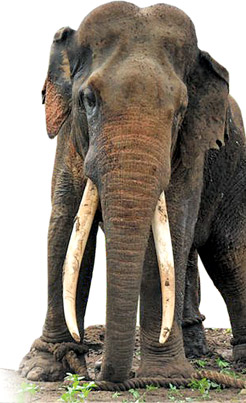... and the magnificent tusker lay still
by Shanika SRIYANANDA
 The wildlife enthusiasts would proudly remember their last glimpse of
the majestic beast in their treks to Galgamuwa. Slowly emerging from the
scrub jungle with its shining long tusks and majestically roaming in the
wild, it would surely make them stand still and to hold their breath in
awe for a moment. The wildlife enthusiasts would proudly remember their last glimpse of
the majestic beast in their treks to Galgamuwa. Slowly emerging from the
scrub jungle with its shining long tusks and majestically roaming in the
wild, it would surely make them stand still and to hold their breath in
awe for a moment.
But not anymore.
Those who captured him in their cameras, now have a picture to save
for the future. The majestic tusker, most probably the only tusker with
the longest tusks among the wild elephants in Sri Lanka, kissed the
earth goodbye last week.
The tusker, a unique gift of nature that many were proud of, died
leaving some doubts and appealing man to leave them alone in their much
loved homelands.
If its death has not moved anybody in authority to implement a proper
strategy to prevent 'jumbo' deaths, it will hopefully help resolve the
decades long cry for and end to the Human-Elephant Conflict (HEC), which
is increasing the death toll rapidly due the escalating fight for a
space to live.
"My heart broke, as I saw the magnificent tusks shining dully, their
full length hidden by the foliage. This was undoubtedly the largest
tusker I had ever seen in this country. I felt so fortunate to have seen
this animal. It was amazing how he had survived all these years, but was
pleasantly reminded that its elusiveness and difficulty to track, was
the very reason it was still alive," a well-known wildlife photographer Vajira Wijegunawardane once said recalling his encounter with the
tusker, this year.
It is a miracle that the 35-year-old elephant which is nearly nine
feet in height owning a magnificent pair of tusks of over 5 feet length,
was kept hidden from the poachers who had mercilessly killed some
tuskers like Kumana tusker to grab their ivory.
|

Dr. Tharaka Prasad |
But, the 'Siyambalangamuwa Maha Etha' (tusker) could not prevent fate
on November 23. Before he stepped into the alien land- Udawalawe, where
he was forced to live, he breathed his last to say 'he is not ready for
a new environment'.
It was cause for the entire country to mourn last week, for, out of a
total population of seven tuskers, the country lost the most 'prized'
one.
The blame has been heaped at the Department of Wildlife Conservation
(DWLC) for its poor handling of the translocation with its poor
facilities and also for continuing with the same ineffective measure -
translocation.
"The Department takes the responsibility and we did our best to
translocate the tusker," DWLC Deputy Director Wildlife Health Management
Dr. Tharaka Prasad, who led the team to capture the elephant, said.
Explaining the 'drama of relocation' step by step, the process took
three hours - to tranquilize, and the chain of activities that lasted
for one and half days until the jumbo was loaded onto the lorry. It was
later confirmed that the cause of death was suffocation due to its bad
posture after being loaded onto the lorry.
"While I was engaged in capturing one elephant at Pandulagama, I was
asked to capture the tusker as it was causing damage, killing a person
and injuring a woman seriously on November 21 night", Dr. Prasad said.
Subsequently his team had to abandon the first mission and rush to the
scene as it appeared urgent. Dr. Prasad, after meeting the relevant
authorities including the Police, started the mission by tracking the
foot path of the elephant which entered the Galgamuwa catchment. The
team encountered the tusker and injected the tranquillizing drugs with a
remote dart.
He said the tusker was identified as a 'trouble maker' and was listed
as the tenth elephant to be translocated among 25 to 30 elephants in the
North-Western region that includes the Kurunegala, Puttalam,
Anuradhapura, Vavuniya, Kilinochchi and upto Jaffna district.
Being an experienced veterinarian, who has translocated over 75
elephants including tuskers, he too believes that translocation is not
the best option. "But what else could be done when an elephant is
causing damage and killing villagers?", he asked.
Refuting all allegations mounting against the DWLC as 'nonsense', he
said his team, including another veterinarian, had taken all the
necessary accepted steps to capture the tusker, which walked for two
hours 50 minutes before it laid down on a paddy field after being
tranquillized. It was allowed to sleep and have a good rest throughout
the night while being under observation. Two ropes were used to tie the
animal which regained consciousness within 25 minutes.
"I personally checked its health before loading to the vehicle which
had transported nearly 60 animals including elephants. The tusker had a
weight of 4,000 kg and was given some sedatives. But the tusker was very
stubborn and damaged the floorboard of the lorry using its right tusk",
he said.
The team planned to release the tusker to the Maduruoya National Park
during sunset but upon reaching Thambutthegama they had noticed it lay
with an uncomfortable and unusual posture with tightly locked limbs and
its right front leg in another hole of the floorboard.
"We tried to rescue the tusker by repairing the floorboard but
noticed that the animal could not stand due to the uncomfortable
posture.
"We tried to rescue him and opened the rear door of the lorry and
loosened the ropes on the front legs", Dr. Prasad said adding all their
attempts to save its life became futile as it died due to external
pressure on lungs and heart.
Dr. Prasad said that some interested parties had held their own
post-mortems that claimed the elephant died due to a high dose of
tranquillizing drugs, transporting the animal at a high speed and that
it was chained.
"I am open for any criticism and I refute all these allegations and
strongly say that we followed all the safe measures and did our best to
translocate the tusker safely. It was given the correct dose of
tranquilizers and it was in good health and we used only sedative
drugs", he said.
Dr. Prasad said the vehicle, which could be driven at a maximum speed
of 80km per hour with an elephant tied safely, was driven at a low speed
as the road was under construction.
He also refuted the claim by private elephant owners that the tusker
was chained and said they never chained a wild animal but used ropes.
"It is the most magnificent tusker that I have seen in the wild", he
said.
The footprints of this magnificent and majestic Siyabalangamuwe 'Maha
Etha' that were left in the jungles of the Galgamuwa would disappear
soon.
The need of the hour is 'learn a lesson' from the death of the
magnificent tusker and end man-made death traps to protect the species
which are already in the brink of extinction.
A prominent legal expert on environmental issues Jagath Gunawardena
who is disappointed about the death of the valuable tusker said it was
an accidental death but stressed the need for looking at the issue more
rationally without 'framing' it as HEC. "The ad hoc measures like
elephant drives and translocations need to be evaluated and the core
issue of the problem is the habitat destruction", he said.
He said people concerned needed to pose the issue as the HEC to
continue to turn a blind eye on the real issue. "There are pocketed
herds due to unplanned development and these issues need to be addressed
separately. Nobody seems to be looking at the cause why this tusker
became a problem. It is mainly because the environment that he lived
could not support his survival due to rapid destruction and degradation
of the eco-system that kept on", he said.
Some studies show that the two main methods - elephant drives and
translocation - adopted by the DWLC have proved unsuccessful so far.
Scientist and the Chairman, Centre for Conservation and Research Dr.
Prithiviraj Fernando said it was a tragic accident that killed the
country's most beautiful and biggest tusker in the wilds but its death
would make the authorities evaluate the success rate of translocation of
elephants.
He said it was not fair to tag the tusker as having died due to
negligence of the DWLC but translocation was not a very effective
measure to resolve the conflict. " The success rate of translocation of
elephants is less than 20 percent as the animal keeps on returning to
its original habitat", Dr. Fernando, who is conducting research on
elephants and its related issues for over 15 years said.
The CCR, which is doing research together with the DWLC, is
especially researching on translocation of elephants for the past six
years. Dr.
Fernando said it was unique the two separate entities carrying out
research jointly and the DWLC, needed to develop the concept of electric
fencing on the problematic elephants rather than forcibly dropping them
to 'alien' habitats.
"A wild elephant which played havoc in the Ahetuwewa, Galgamuwa was
released to the Somawathi National Park over 100 km away from its
environs. But he returned to his habitat trekking 243km within 30-days.
The elephants are very attached to their original environs. Those who
forget their way back home enter into villages or towns and cause
damage. Some settle down in the new location but cause damages to the
surrounding villages", he said.
According to Dr. Fernando, out of 17 elephants that were monitored,
only two settled down in the new habitat while six died after
translocation and others returned.
But he agreed when an elephant was terrorizing a village, there won't
be any other solution than translocating the animal to save the lives of
both.
The social structure of the elephant causes the situation. The single
adults, mainly the males, cause problems. He said it was complex and
difficult to control the situation and isolating all problematic
elephants into a location surrounded by electric fences would be the
ideal option but it has proved a failure so far.
Dr. Fernando said the Siyabalanduwe tusker had not become a problem
or a killer in its lifetime except on the recent two occasions.
"There were no complaints against him. But the two incidents -
killing a man and a woman happened due to their negligence. The man who
was killed by the tusker was fishing at 4 in the morning in the
Galgamuwa Lake, where over 25 elephants were in the Lake to drink water,
and he was attacked. The woman was going to a neighbour's house in the
dark and was said to be attacked by the tusker", he said casting doubts
whether the villagers were able to correctly identify the killer.
The expert suggests the DWLC to have a correct identification system
of the problematic wild elephants, even introducing a radio collar
system to monitor them and to translocate only the problematic animals
into the well-guarded location with electric fences to prevent them
entering the nearby villages.
"I have seen him in the wild and never seen such a majestic tusker",
he said adding the DWLC needs to do more research on the very complex
issue and take more effective measures to prevent such unfortunate
deaths in future.
Its body was buried in the banks of the Siyabalangamuwa Lake, where
it always loved to roam and its tusks will be exhibited at the Wildlife
Museum at Girithale. However, the death of Siyabalangamuwe 'Maha Etha',
which did not have a single fight with a human throughout his life, died
posing a question : Why did he start attacking the villagers recently
and did the wildlife authorities correctly identify the culprit ? |

